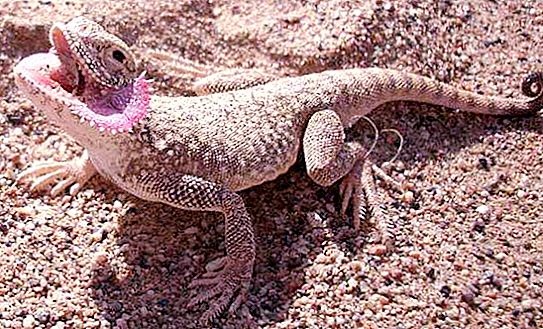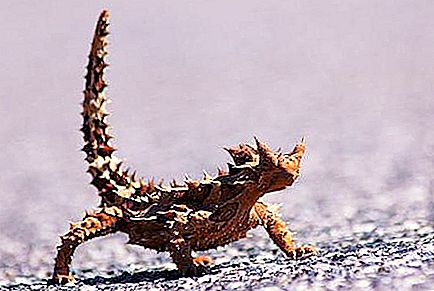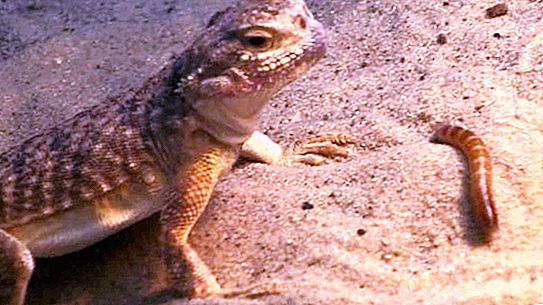The eared round-headed is a resident of the desert, and this lizard got its name because of two large leather folds located in the corners of the mouth. They resemble large ears with serrated fringe at the edges.

Appearance
The long-eared round-headed (photo above) is the largest representative of the genus round-headed. The length of her body reaches 12 cm, and the tail - 15 cm. Her head, trunk and tail are flattened. In the corners of the mouth, as already mentioned, there is a large fold of skin (ears). Its free edge is seated with long conical scales. The back of the head is also dotted with scales. And in general, the whole body of this reptile is covered with scales: on top it is keeled, ribbed, smaller on the sides, conical on the neck, and the throat with faint ribs and a small tip.
Coloring
Usually desert lizards are sand colored, which helps them hide from their enemies. The round-headed is no exception: her body is most often sand-colored with a yellowish or flesh-pink hue; the sides are brighter than the back. The head and body are decorated with camouflage colors, which are irregularly drawn dark lines. They form a complex mosaic of ovals, circles and spots. The underside of the lizard is milky white. There is a black spot on the chest (in females it is less bright than in males). There may be a dark marble pattern on the throat. The tail end is jet black.
Spread
Their distribution is entirely determined by the presence of large masses of moving sands, but the habitat is limited to desert and semi-desert zones in the eastern Ciscaucasia (including foothill Dagestan, the eastern part of Chechnya and Kalmykia). Lizards considered by us are also found in the south of the Astrakhan region, in Central Asia, in Kazakhstan, north-western China, Afghanistan and Iran.
Habitat
A long-eared round-headed is a typical inhabitant of various kinds of loosely fixed and sand dunes with rare grassy and shrubby vegetation. It settles on tops of sand embankments and on roadsides where it creates the isolated settlements. The number of these reptiles is subject to sharp fluctuations, it increases significantly with the withdrawal of young animals. So, in the southern part of Karakum, only 18 individuals were recorded on a two-kilometer route, and 98 individuals were found in Dagestan, in the area of the Sary-Kum dune, on a route of 1, 500 meters. This is considered a record population density for this species of lizard.
Activity
A long-eared round-headed appears after wintering in late March - early April. During the warm winters that occur in Central Asia, some individuals are already active in late February. In the summer, desert lizards (the photos offered to your attention will help to get an idea of this reptile) hide during the day from the sultry sun, appearing only in the morning and evening hours. In early October, these creatures arrange their wintering shelter. To do this, they find inter-plains lowlands and dig straight holes in them up to 90 cm long, which end with small extensions in a layer of wet sand. In the summer period young growth hides in minks, and adults in bad weather, at night or in case of danger burrow into the sand with quick oscillatory movements of the body. At the same time, the eared round-headed, as it were, pushes sand in front of itself, which is picked up by scales on its sides and crumbles onto its back, covering the lizard.
This species of desert inhabitants is well known for its characteristic intimidating pose. The lizard widely spreads and spreads its hind legs, raises the front of the body and opens its mouth wide, while the mucous membrane and the skin folds spread in the corners of the mouth acquire a bright red color. In this case, the round head makes a hissing sound, quickly twists and straightens the tail and jumps in the direction of the enemy. Lizards are very aggressive, and not only in case of protection of the territory or during the mating season, but also at another time. This behavior is characteristic of individuals of different ages and sexes.
Breeding
Mating at the eared roundheads lasts from late April to early July. The first eggs are laid from mid-May until the end of June; the second egg laying occurs at the end of July. The female lays 2 to 6 eggs. Young growth appears in the period from late July to mid-August. The size of the babies is 30-40 mm. Maturity occurs in the second year of life. Young growth usually settles in colonies, and adult individuals prefer individual plots.
What do lizards in the desert eat?
The basis of their diet is made up of various insects. Most often these are bugs, ants, bedbugs, orthoptera, dipterans, butterflies and spiders. Adults can eat desert flowers.







